teaching method
- 格式:doc
- 大小:41.00 KB
- 文档页数:5
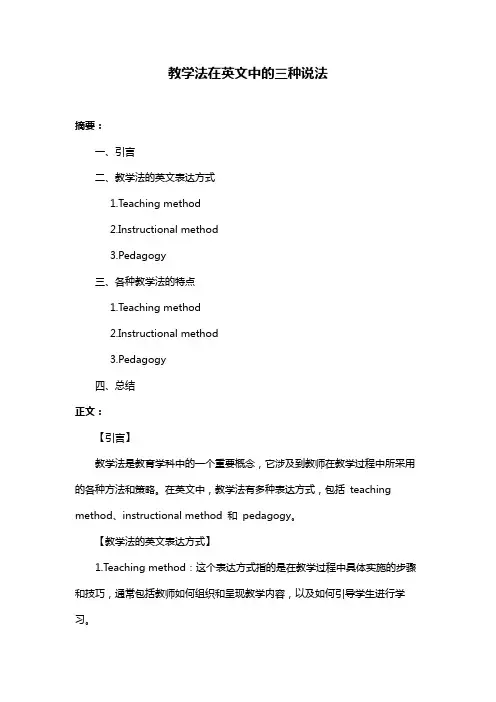
教学法在英文中的三种说法摘要:一、引言二、教学法的英文表达方式1.Teaching method2.Instructional method3.Pedagogy三、各种教学法的特点1.Teaching method2.Instructional method3.Pedagogy四、总结正文:【引言】教学法是教育学科中的一个重要概念,它涉及到教师在教学过程中所采用的各种方法和策略。
在英文中,教学法有多种表达方式,包括teaching method、instructional method 和pedagogy。
【教学法的英文表达方式】1.Teaching method:这个表达方式指的是在教学过程中具体实施的步骤和技巧,通常包括教师如何组织和呈现教学内容,以及如何引导学生进行学习。
2.Instructional method:与teaching method 类似,这个表达方式强调的是教学过程中的方法和技巧。
不过,它更注重教学方法的实际应用,以及这些方法如何帮助学生更好地学习。
3.Pedagogy:这个词汇源自希腊语,原意是“教儿童”。
在现代教育领域,pedagogy 不仅包括教学过程中的方法和技巧,还包括教育理论、课程设计等方面的内容。
【各种教学法的特点】1.Teaching method:关注教学过程中的具体实施步骤和技巧,是教育实践中的一种方法。
2.Instructional method:侧重于教学方法的实际应用,以及这些方法如何帮助学生更好地学习。
3.Pedagogy:既包括教学过程中的方法和技巧,还包括教育理论、课程设计等方面的内容,是一个更为宽泛的概念。
【总结】总之,教学法在英文中有多种表达方式,每种表达方式都有其特定的含义和侧重点。
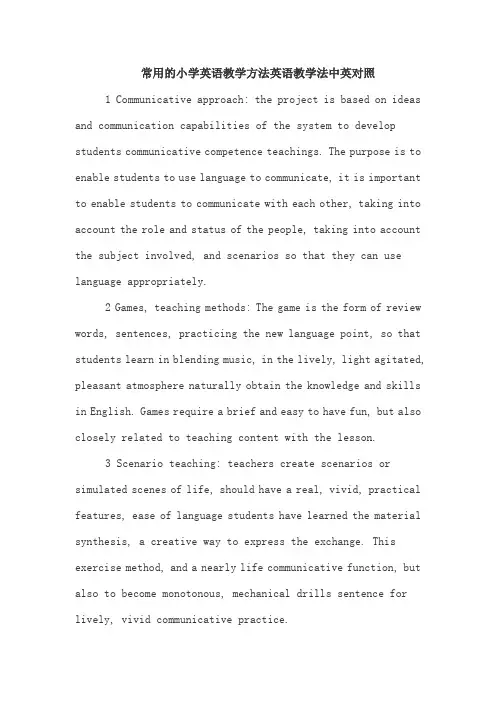
常用的小学英语教学方法英语教学法中英对照1 Communicative approach: the project is based on ideas and communication capabilities of the system to develop students communicative competence teachings. The purpose is to enable students to use language to communicate, it is important to enable students to communicate with each other, taking into account the role and status of the people, taking into account the subject involved, and scenarios so that they can use language appropriately.2 Games, teaching methods: The game is the form of review words, sentences, practicing the new language point, so that students learn in blending music, in the lively, light agitated, pleasant atmosphere naturally obtain the knowledge and skills in English. Games require a brief and easy to have fun, but also closely related to teaching content with the lesson.3 Scenario teaching: teachers create scenarios or simulated scenes of life, should have a real, vivid, practical features, ease of language students have learned the material synthesis, a creative way to express the exchange. This exercise method, and a nearly life communicative function, but also to become monotonous, mechanical drills sentence for lively, vivid communicative practice.4 Action Method: In the lower grades in English teaching, with a specific image of the gestures, movements to support English language learning, stimulate students interest in learning, enhance learning.5 The activity approach: that in accordance with physical and mental development of students at different stages of the process to design, layout situations, provide materials to enable students to actively participate in the free operation, observe and ponder. Through activities for the students themselves understand things, identify problems and arrive at answers, to explore the potential of students.6 Trinity teaching: is based on letters, phonemes, phonetic intrinsic link between their business andcross-relations will be three integrated teaching methods.7 Natural law: This approach allows students to have learned knowledge, based on their level of proficiency to participate in activities.8 Total physical response method: the mobilization of students, sense organs, so that students through the various parts of the body in action to achieve the purpose of memory.9 Cooperative learning: Students are through participation in Pair work and group work activities, forstudents to practice language and learn from each other the conditions and opportunities.10 Functional-notional method: This method is available to the teachers focus on students in a particular session or when a certain context may use the language, so that they perceive their capabilities to use in communication.1、交际法:是根据意念项目和交际功能发展学生交际能力的系统教法。
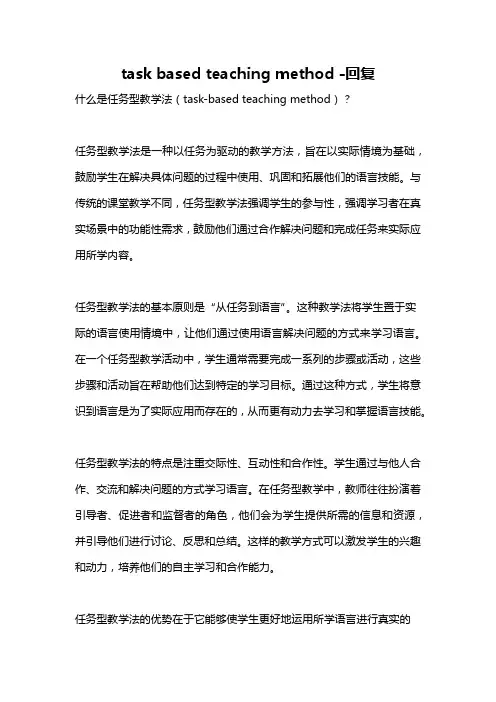
task based teaching method -回复什么是任务型教学法(task-based teaching method)?任务型教学法是一种以任务为驱动的教学方法,旨在以实际情境为基础,鼓励学生在解决具体问题的过程中使用、巩固和拓展他们的语言技能。
与传统的课堂教学不同,任务型教学法强调学生的参与性,强调学习者在真实场景中的功能性需求,鼓励他们通过合作解决问题和完成任务来实际应用所学内容。
任务型教学法的基本原则是“从任务到语言”。
这种教学法将学生置于实际的语言使用情境中,让他们通过使用语言解决问题的方式来学习语言。
在一个任务型教学活动中,学生通常需要完成一系列的步骤或活动,这些步骤和活动旨在帮助他们达到特定的学习目标。
通过这种方式,学生将意识到语言是为了实际应用而存在的,从而更有动力去学习和掌握语言技能。
任务型教学法的特点是注重交际性、互动性和合作性。
学生通过与他人合作、交流和解决问题的方式学习语言。
在任务型教学中,教师往往扮演着引导者、促进者和监督者的角色,他们会为学生提供所需的信息和资源,并引导他们进行讨论、反思和总结。
这样的教学方式可以激发学生的兴趣和动力,培养他们的自主学习和合作能力。
任务型教学法的优势在于它能够使学生更好地运用所学语言进行真实的交际。
通过任务型教学,学生可以在真实的情景中练习语言技能,使语言学习更具实用性和可操作性。
此外,通过任务型教学,学生还可以培养一些与语言技能有关的能力,如有效的沟通、合作和解决问题的能力。
任务型教学法的实施过程可以分为以下步骤:步骤1:任务设置教师需要根据学生的学习需要和兴趣,设定一个具有挑战性的任务。
这个任务应该具有实际的应用价值,能够激发学生参与的兴趣。
步骤2:预热活动在进行任务之前,教师可以通过一些预热活动来提高学生的兴趣和准备工作。
这些活动可以是与任务主题相关的小组讨论、课堂讲解或说唱等。
步骤3:任务介绍和分组教师向学生介绍任务的背景和要求,并将学生分组。
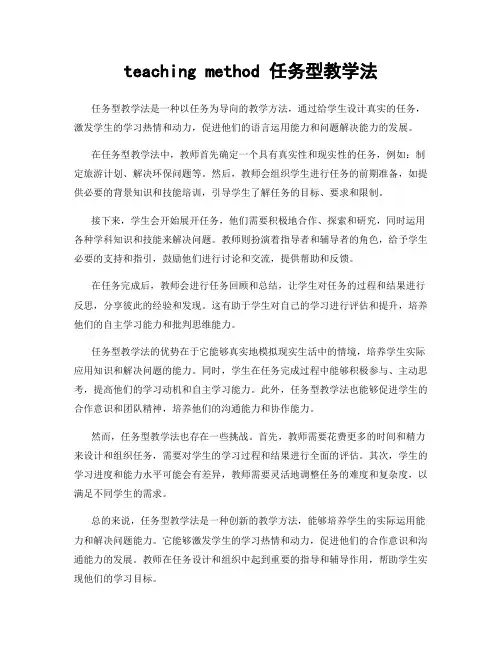
teaching method 任务型教学法任务型教学法是一种以任务为导向的教学方法,通过给学生设计真实的任务,激发学生的学习热情和动力,促进他们的语言运用能力和问题解决能力的发展。
在任务型教学法中,教师首先确定一个具有真实性和现实性的任务,例如:制定旅游计划、解决环保问题等。
然后,教师会组织学生进行任务的前期准备,如提供必要的背景知识和技能培训,引导学生了解任务的目标、要求和限制。
接下来,学生会开始展开任务,他们需要积极地合作、探索和研究,同时运用各种学科知识和技能来解决问题。
教师则扮演着指导者和辅导者的角色,给予学生必要的支持和指引,鼓励他们进行讨论和交流,提供帮助和反馈。
在任务完成后,教师会进行任务回顾和总结,让学生对任务的过程和结果进行反思,分享彼此的经验和发现。
这有助于学生对自己的学习进行评估和提升,培养他们的自主学习能力和批判思维能力。
任务型教学法的优势在于它能够真实地模拟现实生活中的情境,培养学生实际应用知识和解决问题的能力。
同时,学生在任务完成过程中能够积极参与、主动思考,提高他们的学习动机和自主学习能力。
此外,任务型教学法也能够促进学生的合作意识和团队精神,培养他们的沟通能力和协作能力。
然而,任务型教学法也存在一些挑战。
首先,教师需要花费更多的时间和精力来设计和组织任务,需要对学生的学习过程和结果进行全面的评估。
其次,学生的学习进度和能力水平可能会有差异,教师需要灵活地调整任务的难度和复杂度,以满足不同学生的需求。
总的来说,任务型教学法是一种创新的教学方法,能够培养学生的实际运用能力和解决问题能力。
它能够激发学生的学习热情和动力,促进他们的合作意识和沟通能力的发展。
教师在任务设计和组织中起到重要的指导和辅导作用,帮助学生实现他们的学习目标。
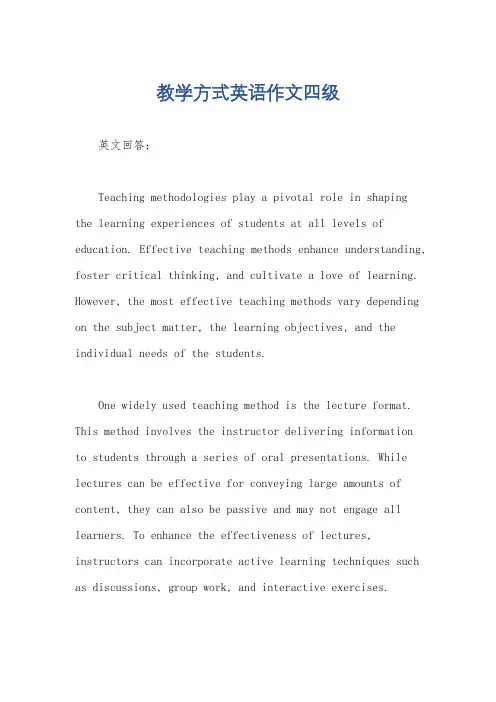
教学方式英语作文四级英文回答:Teaching methodologies play a pivotal role in shaping the learning experiences of students at all levels of education. Effective teaching methods enhance understanding, foster critical thinking, and cultivate a love of learning. However, the most effective teaching methods vary depending on the subject matter, the learning objectives, and the individual needs of the students.One widely used teaching method is the lecture format. This method involves the instructor delivering informationto students through a series of oral presentations. While lectures can be effective for conveying large amounts of content, they can also be passive and may not engage all learners. To enhance the effectiveness of lectures, instructors can incorporate active learning techniques such as discussions, group work, and interactive exercises.Another popular teaching method is the discussion-based format. This method encourages students to actively participate in the learning process by sharing their ideas, asking questions, and engaging in debates. Discussion-based teaching fosters critical thinking, communication skills, and collaboration. To create a productive discussion environment, instructors should establish clear guidelines, encourage diverse perspectives, and provide opportunitiesfor students to reflect on their own understanding.Project-based learning is another engaging teaching method that involves students working on extended projects that require them to apply their knowledge and skills. Through project-based learning, students develop problem-solving abilities, teamwork skills, and real-world experience. To successfully implement project-based learning, instructors should provide clear project guidelines, support students throughout the project process, and assess student learning through both formative and summative assessments.Technology-enhanced teaching methods have also gainedpopularity in recent years. These methods leverage technology to enhance the learning experience through the use of online platforms, simulations, and interactive tools. Technology-enhanced teaching can provide students with personalized learning experiences, access to a wider rangeof resources, and opportunities for collaborative learning. However, it is important for instructors to carefully integrate technology into their teaching practices and ensure that it complements rather than replaces traditional teaching methods.The choice of teaching methods should ultimately be guided by the specific learning objectives, the needs ofthe students, and the context of the learning environment. By thoughtfully selecting and implementing effective teaching methods, instructors can create engaging and meaningful learning experiences that foster student success.中文回答:教学方法对各级教育中学生的学习体验有举足轻重的影响。
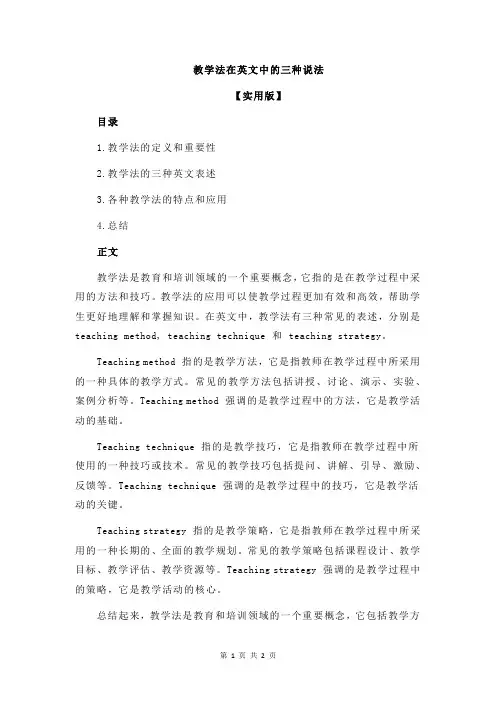
教学法在英文中的三种说法
【实用版】
目录
1.教学法的定义和重要性
2.教学法的三种英文表述
3.各种教学法的特点和应用
4.总结
正文
教学法是教育和培训领域的一个重要概念,它指的是在教学过程中采用的方法和技巧。
教学法的应用可以使教学过程更加有效和高效,帮助学生更好地理解和掌握知识。
在英文中,教学法有三种常见的表述,分别是teaching method, teaching technique 和 teaching strategy。
Teaching method 指的是教学方法,它是指教师在教学过程中所采用的一种具体的教学方式。
常见的教学方法包括讲授、讨论、演示、实验、案例分析等。
Teaching method 强调的是教学过程中的方法,它是教学活动的基础。
Teaching technique 指的是教学技巧,它是指教师在教学过程中所使用的一种技巧或技术。
常见的教学技巧包括提问、讲解、引导、激励、反馈等。
Teaching technique 强调的是教学过程中的技巧,它是教学活动的关键。
Teaching strategy 指的是教学策略,它是指教师在教学过程中所采用的一种长期的、全面的教学规划。
常见的教学策略包括课程设计、教学目标、教学评估、教学资源等。
Teaching strategy 强调的是教学过程中的策略,它是教学活动的核心。
总结起来,教学法是教育和培训领域的一个重要概念,它包括教学方
法、教学技巧和教学策略三个方面。
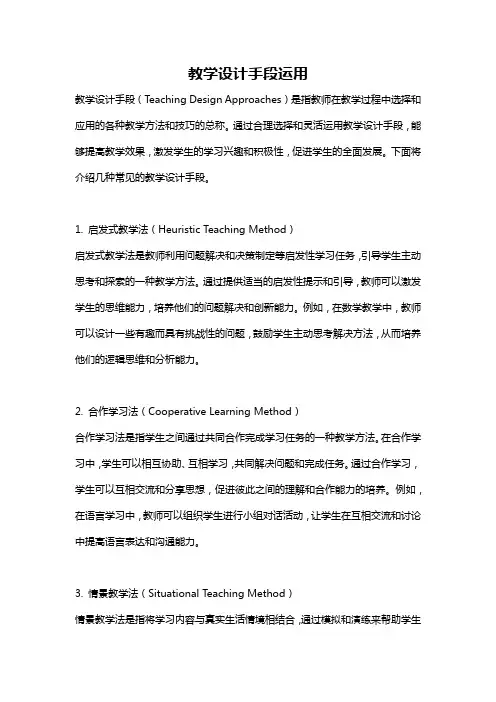
教学设计手段运用教学设计手段(Teaching Design Approaches)是指教师在教学过程中选择和应用的各种教学方法和技巧的总称。
通过合理选择和灵活运用教学设计手段,能够提高教学效果,激发学生的学习兴趣和积极性,促进学生的全面发展。
下面将介绍几种常见的教学设计手段。
1. 启发式教学法(Heuristic Teaching Method)启发式教学法是教师利用问题解决和决策制定等启发性学习任务,引导学生主动思考和探索的一种教学方法。
通过提供适当的启发性提示和引导,教师可以激发学生的思维能力,培养他们的问题解决和创新能力。
例如,在数学教学中,教师可以设计一些有趣而具有挑战性的问题,鼓励学生主动思考解决方法,从而培养他们的逻辑思维和分析能力。
2. 合作学习法(Cooperative Learning Method)合作学习法是指学生之间通过共同合作完成学习任务的一种教学方法。
在合作学习中,学生可以相互协助、互相学习,共同解决问题和完成任务。
通过合作学习,学生可以互相交流和分享思想,促进彼此之间的理解和合作能力的培养。
例如,在语言学习中,教师可以组织学生进行小组对话活动,让学生在互相交流和讨论中提高语言表达和沟通能力。
3. 情景教学法(Situational Teaching Method)情景教学法是指将学习内容与真实生活情境相结合,通过模拟和演练来帮助学生理解和掌握知识的一种教学方法。
通过创造真实生活的情境,激发学生的学习兴趣和积极性,使学习更具有实际意义。
例如,在英语教学中,教师可以设计一些真实场景的对话演练活动,让学生在模拟的情境中使用英语进行交流,提高语言运用能力。
4. 分层次教学法(Hierarchical Teaching Method)分层次教学法是指根据学生的不同学习能力和水平,将学习内容分为不同难度层次,在教学过程中逐步引导学生理解和掌握知识的一种教学方法。
通过分层次教学,教师可以根据学生的个体差异和学习进度,灵活调整教学内容和方法,满足学生的学习需求。
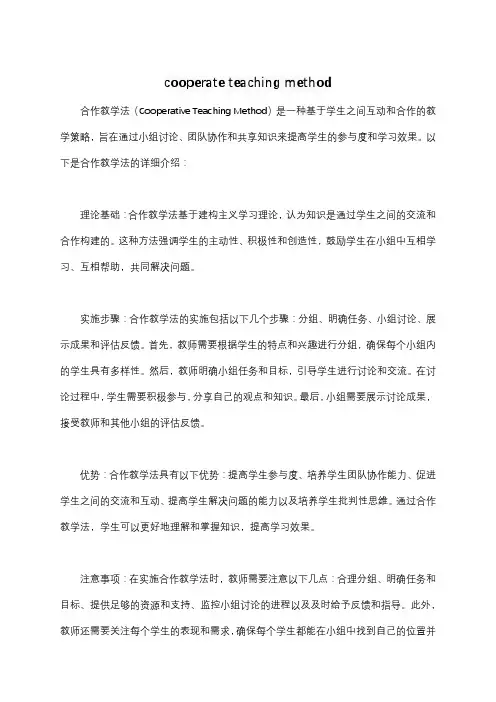
cooperate teaching method
合作教学法(Cooperative Teaching Method)是一种基于学生之间互动和合作的教学策略,旨在通过小组讨论、团队协作和共享知识来提高学生的参与度和学习效果。
以下是合作教学法的详细介绍:
理论基础:合作教学法基于建构主义学习理论,认为知识是通过学生之间的交流和合作构建的。
这种方法强调学生的主动性、积极性和创造性,鼓励学生在小组中互相学习、互相帮助,共同解决问题。
实施步骤:合作教学法的实施包括以下几个步骤:分组、明确任务、小组讨论、展示成果和评估反馈。
首先,教师需要根据学生的特点和兴趣进行分组,确保每个小组内的学生具有多样性。
然后,教师明确小组任务和目标,引导学生进行讨论和交流。
在讨论过程中,学生需要积极参与,分享自己的观点和知识。
最后,小组需要展示讨论成果,接受教师和其他小组的评估反馈。
优势:合作教学法具有以下优势:提高学生参与度、培养学生团队协作能力、促进学生之间的交流和互动、提高学生解决问题的能力以及培养学生批判性思维。
通过合作教学法,学生可以更好地理解和掌握知识,提高学习效果。
注意事项:在实施合作教学法时,教师需要注意以下几点:合理分组、明确任务和目标、提供足够的资源和支持、监控小组讨论的进程以及及时给予反馈和指导。
此外,教师还需要关注每个学生的表现和需求,确保每个学生都能在小组中找到自己的位置并
发挥作用。
总之,合作教学法是一种有效的教学策略,可以提高学生的参与度和学习效果。
在实施过程中,教师需要关注学生的需求和特点,确保每个学生都能在小组中获得成长和进步。
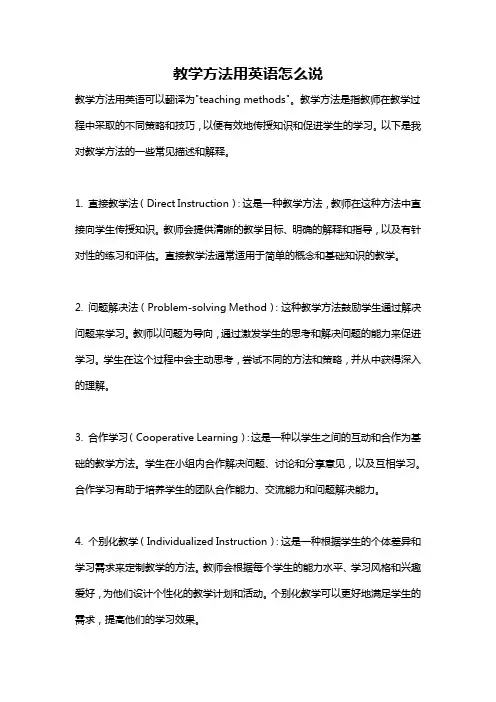
教学方法用英语怎么说教学方法用英语可以翻译为"teaching methods"。
教学方法是指教师在教学过程中采取的不同策略和技巧,以便有效地传授知识和促进学生的学习。
以下是我对教学方法的一些常见描述和解释。
1. 直接教学法(Direct Instruction):这是一种教学方法,教师在这种方法中直接向学生传授知识。
教师会提供清晰的教学目标、明确的解释和指导,以及有针对性的练习和评估。
直接教学法通常适用于简单的概念和基础知识的教学。
2. 问题解决法(Problem-solving Method):这种教学方法鼓励学生通过解决问题来学习。
教师以问题为导向,通过激发学生的思考和解决问题的能力来促进学习。
学生在这个过程中会主动思考,尝试不同的方法和策略,并从中获得深入的理解。
3. 合作学习(Cooperative Learning):这是一种以学生之间的互动和合作为基础的教学方法。
学生在小组内合作解决问题、讨论和分享意见,以及互相学习。
合作学习有助于培养学生的团队合作能力、交流能力和问题解决能力。
4. 个别化教学(Individualized Instruction):这是一种根据学生的个体差异和学习需求来定制教学的方法。
教师会根据每个学生的能力水平、学习风格和兴趣爱好,为他们设计个性化的教学计划和活动。
个别化教学可以更好地满足学生的需求,提高他们的学习效果。
5. 探究式学习(Inquiry-based Learning):这是一种基于学生发现和自主学习的教学方法。
教师会提供一个问题或一个情境,然后鼓励学生主动进行调查、分析和实验,以获得深入的理解和知识。
这种方法培养了学生的探索精神、批判性思维和问题解决能力。
6. 互动式教学(Interactive Teaching):这种教学方法强调教师和学生之间的互动和参与。
教师会利用多种教学工具和技术,如讨论、演示、案例分析和小组活动,促进学生的思考和交流。
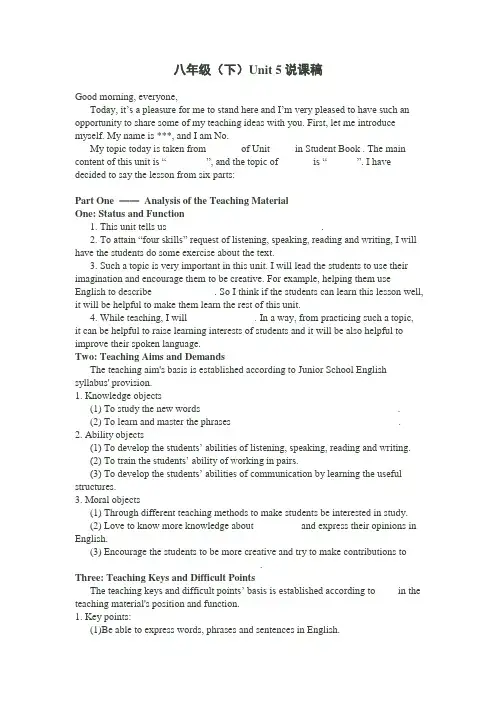
八年级(下)Unit 5说课稿Good morning, everyone,Today, it’s a pleasure for me to stand here and I’m very pleased to have such an opportunity to share some of my teaching ideas with you. First, let me introduce myself. My name is ***, and I am No.______My topic today is taken from ______ of Unit ____ in Student Book . The main content of this unit is “________”, and the topic of ______ is “______”. I have decided to say the lesson from six parts:Part One——Analysis of the Teaching MaterialOne: Status and Function1. This unit tells us_______________________________.2. To attain “four skills” request of listening, speaking, reading and writing, I will have the students do some exercise about the text.3. Such a topic is very important in this unit. I will lead the students to use their imagination and encourage them to be creative. For example, helping them use English to describe ____________. So I think if the students can learn this lesson well, it will be helpful to make them learn the rest of this unit.4. While teaching, I will _____________. In a way, from practicing such a topic, it can be helpful to raise learning interests of students and it will be also helpful to improve their spoken language.Two: Teaching Aims and DemandsThe teaching aim's basis is established according to Junior School English syllabus' provision.1. Knowledge objects(1) To study the new words _______________________________________.(2) To learn and master the phrases _________________________________.2. Ability objects(1) To develop the students’ abilities of listening, speaking, reading and writing.(2) To train the students’ ability of working in pairs.(3) To develop the students’ abilities of communication by learning the useful structures.3. Moral objects(1) Through different teaching methods to make students be interested in study.(2) Love to know more knowledge about_________ and express their opinions in English.(3) Encourage the students to be more creative and try to make contributions to_____________________________________.Three: Teaching Keys and Difficult PointsThe teaching keys and difficult points’ basis is established according to ____in the teaching material's position and function.1. Key points:(1)Be able to express words, phrases and sentences in English.(2). Know about ________________________________________________.2. Difficult points:_________________________________________________________________ Part Two——The Teaching Methods1. Communicative teaching method;2. Audio-visual teaching method;3. Task-based teaching method;4. Classified teaching method.In this lesson I’ll mainly use “Communicative” teaching method, “Audio-visua l” teaching method and “Task-based” teaching method and “Classified” teaching method. That is to say, I’ll let the students get a better understanding of the key structures. I’ll give the students some tasks and arrange some kinds of activities, like talking, watching CAI, and reading in roles.In a word, I want to make the students the real masters in class while the teacher himself acts as director.Part Three——Studying ways1. Teach the students how to be successful language learners.2. Make situation, encourage the students to study the text by themselves.Part Four——Teaching stepsAs this lesson plays an important part in the English teaching of this unit, I have decided the following steps to train their ability of listening, speaking, reading and writing.Step1 Warm-up and Lead-inPurpose of my design: (In this part, have the students say more about what they see or what they don’t see. In this way, they will know today’s lesson has something to do with their discussion.)Step2 Presentation1.Purpose of my design:2.Purpose of my design: (This step is employed to make the students get the general idea of the text. At the same time let the students have a chance to practice their listening and speaking ability.)3.Purpose of my design:Part Five——Summarize and Homework1. Ask the students questions:2. What have we learned from this lesson?3. Fill in the chart according to the text.4. At last, tell students what today’s homework is.Part Six——Blackboard DesignPurpose of my design: Presents the text key content clearly on the blackboard, favors the students to knowledge grasping.OK. That’s all. Thanks for your attention.。
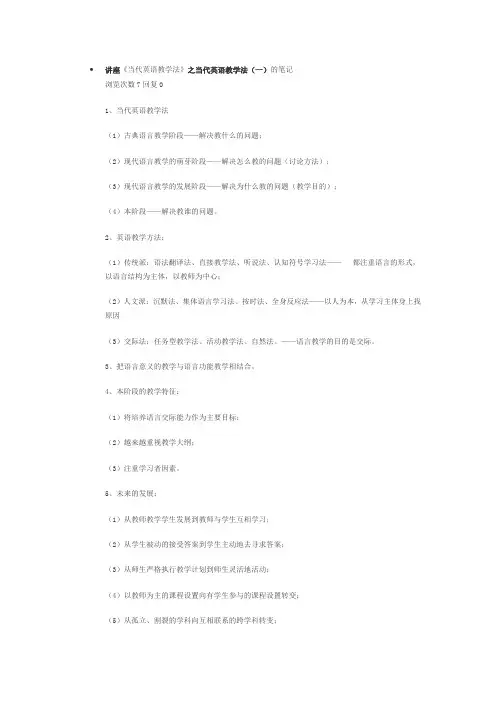
•讲座《当代英语教学法》之当代英语教学法(一)的笔记浏览次数7回复01、当代英语教学法(1)古典语言教学阶段——解决教什么的问题;(2)现代语言教学的萌芽阶段——解决怎么教的问题(讨论方法);(3)现代语言教学的发展阶段——解决为什么教的问题(教学目的);(4)本阶段——解决教谁的问题。
2、英语教学方法:(1)传统派:语法翻译法、直接教学法、听说法、认知符号学习法——都注重语言的形式,以语言结构为主体,以教师为中心;(2)人文派:沉默法、集体语言学习法、按时法、全身反应法——以人为本,从学习主体身上找原因(3)交际法:任务型教学法、活动教学法、自然法。
——语言教学的目的是交际。
3、把语言意义的教学与语言功能教学相结合。
4、本阶段的教学特征:(1)将培养语言交际能力作为主要目标;(2)越来越重视教学大纲;(3)注重学习者因素。
5、未来的发展:(1)从教师教学学生发展到教师与学生互相学习;(2)从学生被动的接受答案到学生主动地去寻求答案;(3)从师生严格执行教学计划到师生灵活地活动;(4)以教师为主的课程设置向有学生参与的课程设置转变;(5)从孤立、割裂的学科向互相联系的跨学科转变;(6)从检测死记硬背书本知识转向评价学生应用所学分析问题、解决问题的能力;(7)从强调课本教学专项利用多种信息资源和生活经验补充书本;(8)从把学生看作有教师进行信息处理的接收器专项把他们看作与教师共同进步的伙伴;(9)教学环境发生变化:从教师做决定、期待学生去执行决定转向学生有权选择自己的学习内容和学习方式6、当今课程的发展趋势:(1)从强调学科内容到强调学习者的经验和体验;(2)从强调目标、计划到强调过程本身的价值;(3)从强调教材的单因素到强调教师/学生、教材、环境四因素的整合;(4)从强调显性课程到强调显性课程与隐性课程的并重。
隐性课程例如美学,国学;(5)从实际课程到强调实际课程与“空无课程”并重;(6)从只强调学校课程到强调学校课程与校外课程的整合;2013-07-22 20:47:3700o暂无评论!•知识与能力;教师与学生;结果与过程;句子与语篇;教学与测试;讲解与探索;传统三步式:presentation;practice;production 阅读计划1、外语教学研究发展的趋势:(1)从语言学理论上讲,指导外语教学的语言学理论从结构主义转成了功能交际主义;(2)从心理学上讲,从行为主义心理学转到了认知心理学;(3)教学重点从注重语言形式到注意意义和功能;(4)教学模式从教师为中心到以学生为中心;(5)学习方式从被动学习到自主学习;(6)从评估方面看,原来强调客观测试,近十年强调主观测试;(7)授课方式从面授到多媒体的,甚至远距离的同步学习。
Grammar-translation approach 语法翻译法Audio-lingual approach 听说法total physical response 全身反应法The direct method 直接法suggestopedia 暗示法The communicative approach 交际法community language teaching 交际教学法Task-based language teaching 任务型教学法Content-based instruction teaching 基于内容的教学法1.Task-Based Language Teaching,即TBLT这是新课标之后实行的新型教学方法——任务型教学,这个意识半会儿说不清楚,你得好好研究一下。
如果成功了,这个教学方法课堂效果会很好。
2.五步教学法:Step 1 Warming upStep 2 Presentation and practiceStep 3 PresentationStep 4 PracticeStep 5 Post Task3.五指教学法:RPCPPStep 1 ReviewStep 2 PresentationStep 3 ConsolidationStep 4 PracticeStep 5 ProjectPresentation4.3P教学法Warming-upPresentationPracticeProductionHomework5交际型教学Communicative Teaching在教学过程中创设或模拟真实情景交际,让学生通过听、说、理解等交际活动不断沟通交流、进行互动的一种教学模式。
教学法在英文中的三种说法:一、Teaching Methods 在英文中,教学法常常被称为Teaching Methods。
这个术语强调了教师通过特定的方法和策略来传授知识和促进学习的过程。
不同的教学方法可以根据学习者的需求和学科的特点来选择,以提高学生的学习效果和学习成果。
常见的教学方法包括讲授法、讨论法、实验法、案例研究法等。
讲授法(Lecture Method)是最常见的教学方法之一,它主要是通过教师的口头讲解来传达知识。
教师通过系统性的演讲和展示,向学生介绍新的概念、原理和理论,并通过实例和案例进行说明以增加理解。
这种方法通常适用于引入新的主题和知识,尤其是在大型课堂中。
讨论法(Discussion Method)是一种互动的教学方法,促进学生思考和参与。
在讨论中,教师充当引导者的角色,鼓励学生表达观点、分享经验和提出问题。
通过相互的交流和思考,学生可以更深入地理解和应用概念,并培养批判性思维和解决问题的能力。
实验法(Experimental Method)是一种基于实践和实验的教学方法,尤其适合自然科学和工程领域。
学生通过实际操作和观察,进行实验和研究,积极参与问题解决过程。
这种方法可以帮助学生巩固理论知识、培养实验设计和数据分析的能力,并加深对科学原理的理解。
二、Pedagogical Approaches Pedagogical Approaches是另一个常用的术语,特指教学过程中教师采用的不同方法和策略。
与教学法类似,Pedagogical Approaches也强调了教师在教学中的角色和影响力。
这些方法可以根据学习者的特点和目标来选择,以实现有效的学习。
分层教学(Differentiated Instruction)是一种注重个性化学习的教学方法。
教师根据学生的不同能力水平、学习风格和兴趣,提供针对性的教学内容和任务。
这样可以最大程度地满足学生的学习需求,并帮助他们发挥潜力,提高学习效果。
常用的小学英语教学方法英语教学法中英对照1 Communicative approach: the project is based on ideas and communication capabilities of the system to develop students communicative competence teachings. The purpose is to enable students to use language to communicate, it is important to enable students to communicate with each other, taking into account the role and status of the people, taking into account the subject involved, and scenarios so that they can use language appropriately.2 Games, teaching methods: The game is the form of review words, sentences, practicing the new language point, so that students learn in blending music, in the lively, light agitated, pleasant atmosphere naturally obtain the knowledge and skills in English. Games require a brief and easy to have fun, but also closely related to teaching content with the lesson.3 Scenario teaching: teachers create scenarios or simulated scenes of life, should have a real, vivid, practical features, ease of language students have learned the material synthesis, a creative way to express the exchange. This exercise method, and a nearly life communicative function, but also to become monotonous, mechanical drills sentence for lively, vivid communicative practice.4 Action Method: In the lower grades in English teaching, with a specific image of the gestures, movements to support English language learning, stimulate students interest in learning, enhance learning.5 The activity approach: that in accordance with physical and mental development of students at different stages of the process to design, layout situations, provide materials to enable students to actively participate in the free operation, observe and ponder. Through activities for the students themselves understand things, identify problems and arrive at answers, to explore the potential of students.6 Trinity teaching: is based on letters, phonemes, phonetic intrinsic link between their business andcross-relations will be three integrated teaching methods.7 Natural law: This approach allows students to have learned knowledge, based on their level of proficiency to participate in activities.8 Total physical response method: the mobilization of students, sense organs, so that students through the various parts of the body in action to achieve the purpose of memory.9 Cooperative learning: Students are through participation in Pair work and group work activities, forstudents to practice language and learn from each other the conditions and opportunities.10 Functional-notional method: This method is available to the teachers focus on students in a particular session or when a certain context may use the language, so that they perceive their capabilities to use in communication.1、交际法:是根据意念项目和交际功能发展学生交际能力的系统教法。
英语教学方法名称
以下是一些常见的英语教学方法名称:
1. 情景教学法(Situational Teaching Method)
2. 音乐教学法(Music Teaching Method)
3. 交际教学法(Communicative Language Teaching)
4. 语言经验教学法(Language Experience Approach)
5. 任务教学法(Task-based Learning)
6. 联想教学法(Association Teaching Method)
7. 团体教学法(Group Teaching Method)
8. 游戏教学法(Play Method)
9. 直接法(Direct Method)
10. 快乐教学法(Happy Teaching)
11. 翻译法(Translating Method)
12. 讲授法(Expository Method)
13. 语法翻译法(Grammar-Translation Method)
14. 听说教学法(Audio-Lingual Method)
这些教学方法在英语教学中起着重要的作用,每种方法都有其独特的特点和适用范围。
在实际教学中,教师可以根据学生的需求和实际情况选择合适的教学方法。
hierarchical teaching method
层级教学法是一种教学方法,其核心思想是从基础知识逐渐深入到更复杂和抽象的概念。
这种方法可以帮助学生更好地理解和掌握知识。
在层级教学法中,教师首先要评估学生的基础知识水平,然后按照适当的顺序逐步引导学生学习更高级的概念。
例如,在学习数学时,教师会教授基本的数学概念,如加减乘除。
然后,教师会引导学生学习更复杂的概念,如分数、比例和代数。
层级教学法的优点之一是帮助学生建立坚实的基础知识。
学生可以更好地理解基本概念,并将其应用于更高级的概念中。
此外,层级教学法还可以帮助学生更好地记忆和理解知识,因为他们可以将新的内容与他们已经掌握的知识联系起来。
然而,在使用层级教学法时,教师需要花费更多的时间和精力来准备教材和教学计划。
教师需要了解每个学生的基础知识水平,并根据学生的需要进行调整。
此外,教师还需要确保学生在每个层次上都理解并掌握了知识,这需要更多的时间和努力。
总的来说,层级教学法可以帮助学生更好地理解和掌握知识,建立坚实的基础知识,但需要教师投入更多的时间和精力。
在教学实践中,教师可以根据学生的实际情况决定是否使用此种教学方法。
- 1 -。
Teaching methodA teaching method comprises the principles and methods used for instruction. Commonly used teaching methods may include class participation, demonstration, recitation, memorization, or combinations of these. The choice of teaching method or methods to be used depends largely on the information or skill that is being taught, and it may also be influenced by the aptitude and enthusiasm of the students.Methods of instructionExplainingExplaining, or lecturing, is the process of teaching by giving spoken explanations of the subject that is to be learned. Lecturing is often accompanied by visual aids to help students visualize an object or problem.DemonstratingDemonstrating is the process of teaching through examples or experiments. For example, a science teacher may teach an idea by performing an experiment for students. A demonstration may be used to prove a fact through a combination of visual evidence and associated reasoning.Demonstrations are similar to written storytelling and examples in that they allow students to personally relate to the presented information. Memorization of a list of facts is a detached and impersonal experience, whereas the same information, conveyed through demonstration, becomes personally relatable. Demonstrations help to raise student interest and reinforce memory retention because they provide connections between facts and real-world applications of those facts. Lectures, on the other hand, are often geared more towards factual presentation than connective learning.CollaboratingCollaboration allows students to actively participate in the learning process by talking with each other and listening to other points of view. Collaboration establishes a personal connection between students and the topic of study and it helps students think in a less personally biased way. Group projects and discussions are examples of this teaching method. Teachers may employ collaboration to assess student's abilities to work as a team, leadership skills, or presentation abilities.Collaborative discussions can take a variety of forms, such as fishbowl discussions. After some preparation and with clearly defined roles, a discussion may constitute most of a lesson, with the teacher only giving short feedback at the end or in the following lesson.Learning by teachingIn this teaching method, students assume the role of teacher and teach their peers. Students who teach others as a group or as individuals must study and understand a topic well enough to teach it to their peers. By having students participate in the teaching process, they gain self-confidence and strengthen their speaking and communication skills.Ancient educationAbout 3000 BC, with the advent of writing, education became more conscious or self-reflecting, with specialized occupations such as scribe and astronomer requiring particular skills and knowledge. Philosophy in ancientGreece led to questions of educational method entering national discourse.In his literary work The Republic, Plato described a system of instruction that he felt would lead to an ideal state. In his dialogues, Plato described the Socratic method, a form of inquiry and debate intended to stimulate critical thinking and illuminate ideas.It has been the intent of many educators since, such as the Roman educator Quintilian, to find specific, interesting ways to encourage students to use their intelligence and to help them to learn.Medieval educationComenius, in Bohemia, wanted all children to learn. In his The World in Pictures, he created an illustrated textbook of things children would be familiar with in everyday life and used it to teach children. Rabelais described how the student Gargantua learned about the world, and what is in it.Much later, Jean-Jacques Rousseau in his Emile, presented methodology to teach children the elementsof science and other subjects. During Napoleonic warfare, the teaching methodology of Johann HeinrichPestalozzi of Switzerland enabled refugee children, of a class believed to be unteachable[by whom?], to learn. He described this in his account of an educational experiment at Stanz.[citation needed] He felt the key to have children learn is for them to be loved.[citation needed]19th century - compulsory educationMain article: Prussian education systemThe Prussian education system was a system of mandatory education dating to the early 19th century. Parts ofthe Prussian education system have served as models for the education systems in a number of other countries, including Japan and the United States. The Prussian model required classroom management skills to be incorporated into the teaching process.20th centuryNewer teaching methods may incorporate television, radio, computer, and other modern devices. Someeducators[who?] believe that the use of technology, while facilitating learning to some degree, is not a substitute for educational methods that encourage critical thinking and a desire to learn. Inquiry learning is another modern teaching method.。
In applied linguistics, the grammar translation method is a foreign language teaching method derived from the classical (sometimes called traditional) method of teaching Greek and Latin. The method requires students to translate whole texts word for word and memorize numerous grammatical rules and exceptions as well as enormous vocabulary lists. The goal of this method is to be able to read and translate literary masterpieces and classics.Classes were conducted in the native language. A chapter in a distinctive textbook of this method would begin with a massive bilingual vocabulary list. Grammar points would come directly from the texts and be presented contextually in the textbook, to be explained elaborately by the instructor. Grammar thus provided the rules for assembling words into sentences. Tedious translation and grammar drills would be used to exercise and strengthen the knowledge without much attention to content. Sentences would be deconstructed and translated. Eventually, entire texts would be translated from the target language into the native language and tests would often ask students to replicate classical texts in the target language. Very little attention was placed on pronunciation or any communicative aspects of the language. The skill exercised was reading, and then only in the context of translation.A number of methods and techniques have evolved for the teaching of English and also other foreign languages in the recent past, yet this method is still in use in many parts of India. It maintains the mother tongue of the learner as the reference particularly in the process of learning the second/foreign languages. The main principles on which the Grammar Translation Method is based are the following:Translation interprets the words and phrases of the foreign languages in the best possible manner. The phraseology and the idiom of the target language can best be assimilated in the process of interpretation.The structures of the foreign languages are best learned when compared and contrast with those of mother tongue.In this method, while teaching the text book the teacher translates every word and phrase from English into the learners mother tongue. Further, students are required to translate sentences from their mother tongue into English. These exercises in translation are based on various items covering the grammar of the target language. The method emphasizes the study of grammar through deduction that is through the study of the rules of grammar. A contrastive study of the target language with the mother tongue gives an insight into the structure not only of the foreign language but also of the mother tongue.AdvantagesThe grammar translation method has two main advantages.The phraseology of the target language is quickly explained. Translation is the easiest way of explaining meanings or words and phrases from one language into another. Any other method of explaining vocabulary items in the second language is found time consuming. A lot of time is wasted if the meanings of lexical items are explained through definitions and illustrations in the second language. Further, learners acquire some sort of accuracy in understanding synonyms inthe source language and the target language.Teacher’s labor is saved. Since the textbooks are tau ght through the medium of the mother tongue, the teacher may ask comprehension questions on the text taught in the mother tongue. Pupils will not have much difficulty in responding to questions in the mother tongue. So, the teacher can easily assess whether the students have learned what he has taught them. Communication between the teacher and the learner does not cause linguistic problems. Even teachers who are not fluent in English can teach English through this method. That is perhaps the reason why this method has been practiced so widely and has survived so long.[edit] DisadvantagesAlong with its advantages, the grammar translation method comes with many disadvantages.It is an unnatural method. The natural order of learning a language is listening, speaking, reading and writing. That is the way a child learns his mother tongue in natural surroundings; but, in the Grammar Translation Method the teaching of the second language starts with the teaching of reading. Thus, the learning process is reversed. This poses problems.Speech is neglected. The Grammar Translation Method lays emphasis on reading and writing. It neglects speech. Thus, the students who are taught English through this method fail to express themselves adequately in spoken English. Even at the undergraduate stage they feel shy of communicating using English. It has been observed that in a class, which is taught English through this method, learners listen to the mother tongue more than that to the second/foreign language. Since language learning involves habit formation such students fail to acquire a habit of speaking English. Therefore, they have to pay a heavy price for being taught through this method. Exact translation is not possible. Translation is, indeed, a difficult task and exact translation from one language to another is not always possible. A language is the result of various customs, traditions, and modes of behavior of a speech community and these traditions differ from community to community. There are several lexical items in one language, which have no synonyms/equivalents in another language. For example, the meaning of the English word ‘table’ does not fit in such expressions as 'table of contents’, ‘table of figures’, ‘multiplication table’, ‘time table’ and ‘table the resolution’, etc. English prepositions are also difficult to translate. Consider sentences such as ‘We see with our eyes’, ‘Bombay is far from Delhi’, ‘He died of cholera’, 'He succeeded through hard work’. In these sentences ‘with’, ‘from’, ‘of’, and ‘through’ can be translated into the Hindi preposition ‘se’ and vice versa. Each language has its own structure, idiom and usage, which do not have their exact counterparts in another language. Thus, translation should be considered an index of one’s profi ciency in a language.It does not give pattern practice. A person can learn a language only when he internalizes its patterns to the extent that they form his habit. But the Grammar Translation Method does not provide any such practice to the learner of a language. It rather attempts to teach language through rules and not by use. Researchers in linguistics have proved that to speak any language, whether native or foreign, entirely by rule is quite impossible. Language learning means acquiring certain skills, which can be learned through practice and not by just memorizing rules. The persons who have learned a foreign or second language through this method find it difficult to give up the habitof first thinking in their mother tongue and then translating their ideas into the second language. They, therefore, fail to get proficiency in the second language approximating that in the first language. The method, therefore, suffers from certain weaknesses for which there is no remedy.听说教学法(Audio-lingual method)The audio-lingual method, Army Method, or New Key[1], is a style of teaching used in teaching foreign languages. It is based on behaviorist theory, which professes that certain traits of living things, and in this case humans, could be trained through a system of reinforcement—correct use of a trait would receive positive feedback while incorrect use of that trait would receive negative feedback.This approach to language learning was similar to another, earlier method called the direct method. Like the direct method, the audio-lingual method advised that students be taught a language directly, without using the students' native language to explain new words or grammar in the target language. However, unlike the direct method, the audio-lingual method didn’t focus on teaching vocabulary. Rather, the teacher drilled students in the use of grammar.ExamplesInflection : Teacher : I ate the sandwich. Student : I ate the sandwiches.Replacement : Teacher : He bought the car for half-price. Student : He bought it for half-price. Restatement : Teacher : Tell me not to smoke so often. Student : Don't smoke so often!The following example illustrates how more than one sort of drill can be incorporated into one practice session :“Teacher: There's a cup on the table ... repeatStudents: There's a cup on the tableTeacher: SpoonStudents: There's a spoon on the tableTeacher: BookStudents: There's a book on the tableTeacher: On the chairStudents: There's a book on the chairetc.”[2]全身肢体反应教学法(total physical response)Total Physical Response (TPR) is a method developed by Dr. James J. Asher, a professor emeritus of psychology at San José State University, to aid learning second languages. The method relies on the assumption that when learning a second or additional language, language is internalized through a process of codebreaking similar to first language development and that the process allows for a long period of listening and developing comprehension prior to production. Students respond to commands that require physical movement. TPR is primarily used by ESL/EAL teachers,[1][2] although the method is used in teaching other languages as well.[3][4][5] The method became popular in the 1970s and attracted the attention or allegiance of some teachers, but it has not received generalized support from mainstream educators.[6]Classroom usageIn the classroom the teacher and students take on roles similar to that of the parent and childrespectively. Students must respond physically to the words of the teacher. The activity may be a simple game such as Simon Says or may involve more complex grammar and more detailed scenarios.TPR can be used to practice and teach various things. It is well suited to teaching classroom language and other vocabulary connected with actions. It can be used to teach imperatives and various tenses and aspects. It is also useful for story-telling.Because of its participatory approach, TPR may also be a useful alternative teaching strategy for students with dyslexia or related learning disabilities, who typically experience difficulty learning foreign languages with traditional classroom instruction.[7]According to its proponents, it has a number of advantages: Students will enjoy getting up out of their chairs and moving around. Simple TPR activities do not require a great deal of preparation on the part of the teacher. TPR is aptitude-free, working well with a mixed ability class, and with students having various disabilities.[8] It is good for kinesthetic learners who need to be active in the class. Class size need not be a problem, and it works effectively for children and adults.[9] However, it is recognized that TPR is most useful for beginners, though it can be used at higher levels where preparation becomes an issue for the teacher. It does not give students the opportunity to express their own thoughts in a creative way. Further, it is easy to overuse TPR-- "Any novelty, if carried on too long, will trigger adaptation."[9] It can be a challenge for shy students. Additionally, the nature of TPR places an unnaturally heavy emphasis on the use of the imperative mood, that is to say commands such as "sit down" and "stand up". These features are of limited utility to the learner, and can lead to a learner appearing rude when attempting to use his new language. Of course, as a TPR class progresses, group activities and descriptions can be used which continue the basic concepts of TPR into full communication situations交际教学法(communicative language teachingmethod)Community language learning (CLL) is an approach in which students work together to develop what aspects of a language they would like to learn. The teacher acts as a counsellor and a paraphraser, while the learner acts as a collaborator, although sometimes this role can be changed.Methods[edit] Natural ApproachThe foreign language learner's tasks, according to CLL are (1) to apprehend the sound system of the language (2) assign fundamental meanings to individual lexical units and (3) construct a basic grammar.In these three steps, the CLL resembles the Natural Approach to language teaching in which a learner is not expected to speak until he has achieved some basic level of comprehension.[3] There are 5 stages of development in this method.“Birth” stage: feeling of security and belonging are established.As the learners' ability improve, they achieve a measure of independence from the parent. Learners can speak independently.The learners are secure enough to take criticism and being corrected.The child becomes an adult and becomes the knower.Applied to language instruction, and often within the context of the language lab, this means that the instructor would present the correct model of a sentence and the students would have to repeat it. The teacher would then continue by presenting new words for the students to sample in the same structure. In audio-lingualism, there is no explicit grammar instruction—everything is simply memorized in form. The idea is for the students to practice the particular construct until they can use it spontaneously. In this manner, the lessons are built on static drills in which the students have little or no control on their own output; the teacher is expecting a particular response and not providing that will result in a student receiving negative feedback. This type of activity, for the foundation of language learning, is in direct opposition with communicative language teaching.。